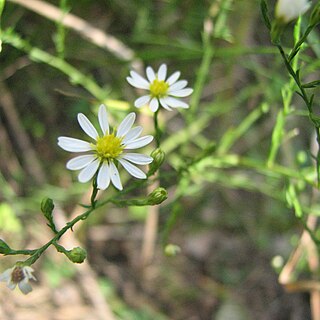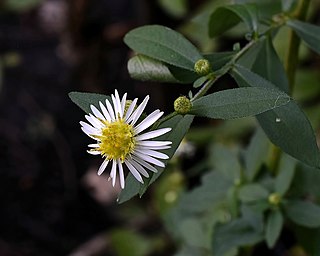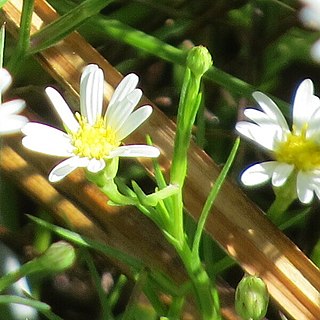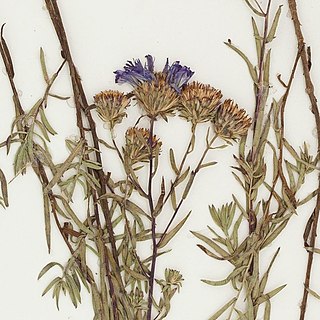
Symphyotrichum novae-angliae is a species of flowering plant in the aster family (Asteraceae) native to central and eastern North America. Commonly known as New England aster, hairy Michaelmas-daisy, or Michaelmas daisy, it is a perennial, herbaceous plant usually between 30 and 120 centimeters tall and 60 to 90 cm wide.

Symphyotrichum is a genus of over 100 species and naturally occurring hybrids of herbaceous annual and perennial plants in the composite family, Asteraceae, most which were formerly treated within the genus Aster. The majority are endemic to North America, but several also occur in the West Indies, Central and South America, as well as one species in eastern Eurasia. Several species have been introduced to Europe as garden specimens, most notably New England aster and New York aster.

Symphyotrichum lateriflorum is a species of flowering plant in the aster family (Asteraceae). Commonly known as calico aster, starved aster, and white woodland aster, it is native to eastern and central North America. It is a perennial and herbaceous plant that may reach heights up to 120 centimeters and widths up to 30 centimeters.

Symphyotrichum ascendens is a species of flowering plant in the family Asteraceae known by the common names western aster, long-leaved aster, and Rocky Mountain aster. Blooming July–September, it is native to western North America and can be found at elevations of 500–3,200 m (1,600–10,500 ft) in several habitats.

Symphyotrichum pilosum is a perennial, herbaceous, flowering plant in the Asteraceae family native to central and eastern North America. It is commonly called hairy white oldfield aster, frost aster, white heath aster, heath aster, hairy aster, common old field aster, old field aster, awl aster, nailrod, and steelweed. There are two varieties: Symphyotrichumpilosum var.pilosum, known by the common names previously listed, and Symphyotrichumpilosum var.pringlei, known as Pringle's aster. Both varieties are conservationally secure globally and in most provinces and states where they are native.

Symphyotrichum depauperatum, commonly known as serpentine aster or starved aster, is a rare species in the family Asteraceae adapted to serpentine barrens, an ecosystem with a high concentration of toxic metals in the soil. It has been found in Pennsylvania, Maryland, and on some diabase glades in North Carolina. It grows to 50 centimeters and has white ray florets surrounding a center of yellow disk florets.

Symphyotrichum lanceolatum is a species of flowering plant in the family Asteraceae native to North America. Common names include panicled aster, lance-leaved aster, and white panicled aster. It is a perennial, herbaceous plant that may reach 1.5 meters tall or more, sometimes approaching 2 m. The lance-shaped leaves are generally hairless but may feel slightly rough to the touch on the top because of tiny bristles. The flowers grow in clusters and branch in panicles. They have 16–50 white ray florets that are up to 14 millimeters long and sometimes tinged pink or purple. The flower centers consist of disk florets that begin as yellow and become purple as they mature.

Symphyotrichum georgianum is a rare species of flowering plant in the Asteraceae, the aster family. Its common name is Georgia aster. It is native to the southeastern United States where it is known from Alabama, Florida, Georgia, North Carolina, and South Carolina. As of 2013, it may be extirpated from the state of Florida.

Symphyotrichum falcatum is a species of flowering plant in the family Asteraceae. Commonly called white prairie aster and western heath aster, it is native to a widespread area of central and western North America.

Symphyotrichum dumosum is a species of flowering plant of the family Asteraceae commonly known as rice button aster and bushy aster. It is native to much of eastern and central North America, as well as Haiti and Dominican Republic. It is a perennial, herbaceous plant that may reach a height of 1 meter.

Symphyotrichum patens, commonly known as late purple aster or spreading aster, is a perennial, herbaceous plant found in the eastern United States.

Symphyotrichum urophyllum is a species of flowering plant in the family Asteraceae native to eastern North America, commonly known as arrowleaf aster.

Symphyotrichum ontarionis is a species of flowering plant in the family Asteraceae native to eastern North America. Commonly known as Ontario aster and bottomland aster, it is a perennial, herbaceous plant that may reach heights of 120 centimeters. Each flower head has many tiny florets put together into what appear as one.

Symphyotrichum racemosum is a species of flowering plant native to parts of the United States and introduced in Canada. It is known as smooth white oldfield aster and small white aster. It is a perennial, herbaceous plant in the family Asteraceae. It is a late-summer and fall blooming flower.

Symphyotrichum potosinum is a species of flowering plant in the family Asteraceae native to Mexico and the U.S. state of Arizona. Commonly known as Santa Rita Mountain aster, it is a perennial, herbaceous plant that may reach heights of 15 to 45 centimeters.

Symphyotrichum spathulatum is a species of flowering plant in the family Asteraceae native to western North America including northwestern Mexico. Commonly known as western mountain aster, it is a perennial, herbaceous plant that may reach 20 to 80 centimeters tall. Its flowers, which open in July and August, have violet ray florets and yellow disk florets.

Symphyotrichum turneri is a species of flowering plant in the family Asteraceae native to Durango, Mexico.

Symphyotrichinae is a subtribe of plants in the family Asteraceae containing six genera primarily of North American origin. In addition to Symphyotrichum, the largest and the type genus, the genera are Almutaster, Ampelaster, Canadanthus, Psilactis, and Sanrobertia.

Symphyotrichum kentuckiense is a rare species of flowering plant in the Asteraceae family and is commonly known as Kentucky aster, Price's aster, Miss Price's aster, Sadie's aster, or lavender oldfield aster. It is a perennial, herbaceous plant that is endemic to broken limestone cedar glades and roadsides in Alabama, Georgia, Kentucky, and Tennessee. It blooms from August through October, reaches heights between 30 centimeters and 100 cm (3.3 ft), and has green to reddish-brown stems. It is a nearly hairless plant with blue to blue-violet ray florets.























